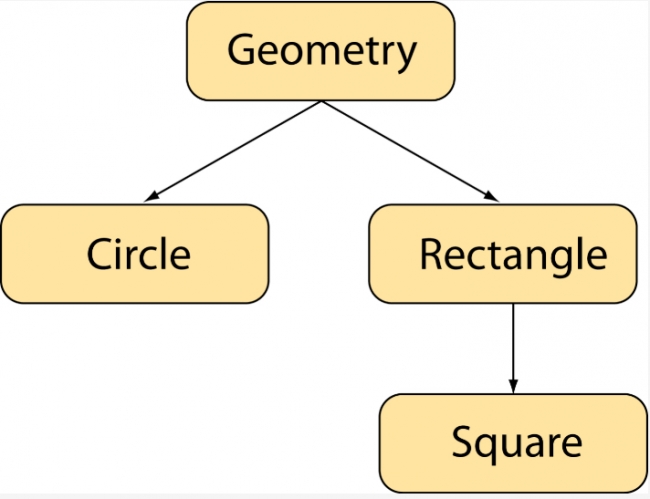Overall, the new definitions of Circle and Rectangle have gotten shorter and redundant code like the implementation of move(…) only appears once, namely in the most general class Geometry. Let’s add another class to the hierarchy, a class for axis-aligned Square objects. Of course, you could argue that our class Rectangle is already sufficient to represent such squares. That is correct but we want to illustrate how it would look if you specialize a class already derived from Geometry further and one could well imagine a more complex version of our toy GIS example in which squares would add some other form of specialization. The resulting class hierarchy will then look like in the image below. The new class Square is a derived class of class Rectangle (so Rectangle is its base class) but it is also indirectly derived from class Geometry. Therefore, we say both Geometry and Rectangle are superclasses of Square and Square is a subclass of both these classes. Please note that the way we have been introducing these terms here, the terms base and derived class desribe the relationship between two nodes directly connected by a single arrow in the hierarchy graph, while superclass and subclass are more general and describe the relationship between two classes that are connected via any number of directed arrows in the graph.

Here is the code for class Square:
class Square(Rectangle):
def __init__(self, x = 0.0, y = 0.0, sideLength = 1.0):
super(Square,self).__init__(x, y, sideLength, sideLength)
def __str__(self):
return 'Square with coordinates {0}, {1} and sideLength {2}'.format(self.x, self.y, self.width )
square1 = Square(5, 5, 8)
print(square1.computeArea())
print(square1.computePerimeter())
square1.move(2,2)
print(square1)
Right, the definition of Square is really short; we only define a new constructor that only takes x and y coordinates and a single sideLength value rather than width and height values. In the constructor we call the constructor of the base class Rectangle and provide sideLength for both the width and height parameters of that constructor. There are no new instance variables to initialize, so this is all that needs to happen in the constructor. Then the only other thing we have to do is override the __str__() method to produce some square-specific output message using self.width for the side length information for the square. (Of course, we could have just as well used self.height here.) The implementations of methods computeArea() and computePerimeter() are inherited from class Rectangle and the implementation of move(…) indirectly from class Geometry.
Now that we have this class hierarchy consisting of one abstract and three instantiable classes, the following code example illustrates the power of polymorphism. Imagine that in our toy GIS we have created a layer consisting of objects of the different geometry types. If we now want to implement a function computeTotalArea(…) that computes the combined area of all the objects in a layer, this can be done like this:
layer = [ circle1, rectangle1, square1, Circle(3,3,9), Square(30, 20, 5) ] def computeTotalArea(geometryLayer): area = 0 for geom in geometryLayer: area += geom.computeArea() return area print(computeTotalArea(layer))
Output: 677.6282702997526
In line 1, you see how we can create a list of objects of the different classes from our hierarchy to represent the layer. We included objects that we already created previously in variables circle1, rectangle1, and square1 but also added another Circle and another Square object that we are creating directly within the square brackets […]. The function computeTotalArea(…) then simply takes the layer list, loops through its elements, and calls computeArea() for each object in the list. The returned area values are added up and returned as the total area.
The code for this is really compact and elegant without any need for if-else to realize some case-distinction based on the geometry type of the given object in variable geom. Let’s further say we would like to add another class to our hierarchy, a class Polygon that – since polygons are neither specialized versions of circles or rectangles – should be derived from the root class Geometry. Since polygons are much more complex than the basic shapes we have been dealing with so far (e.g. when it comes to computing their area), we will not provide a class definition here. But, once we have written the class, we can include polygons in the layer list from the previous example …
layer = [ Polygon(…), circle1, rectangle1, square1, Circle(3,3,9), Square(30, 20, 5) ]
… and the code for computing the total area will immediately work without further changes. All changes required for making this addition are nicely contained within the class definition of Polygon because of the way inheritance and polymorphism are supported in Python.